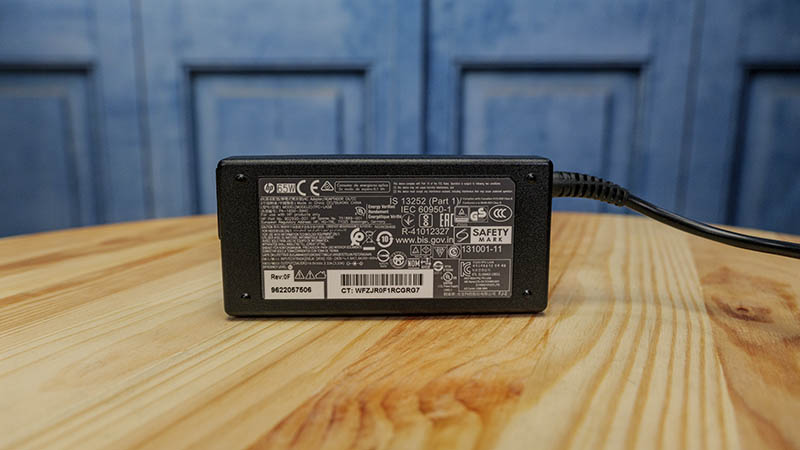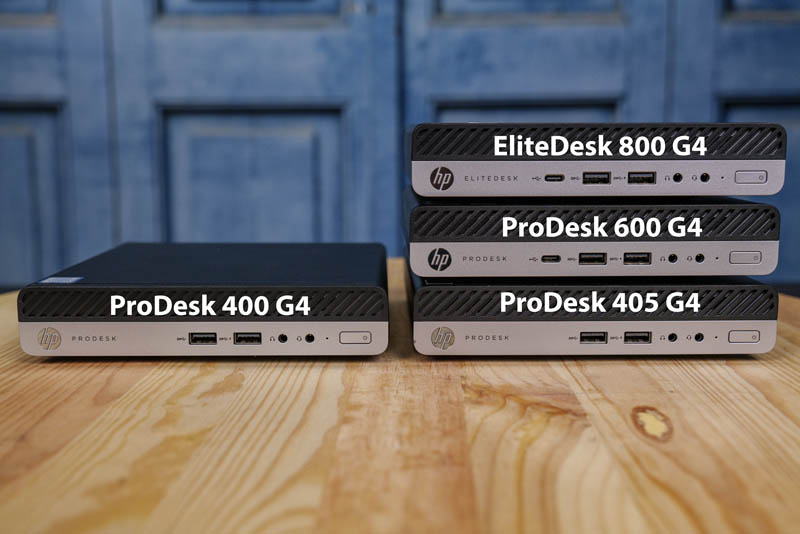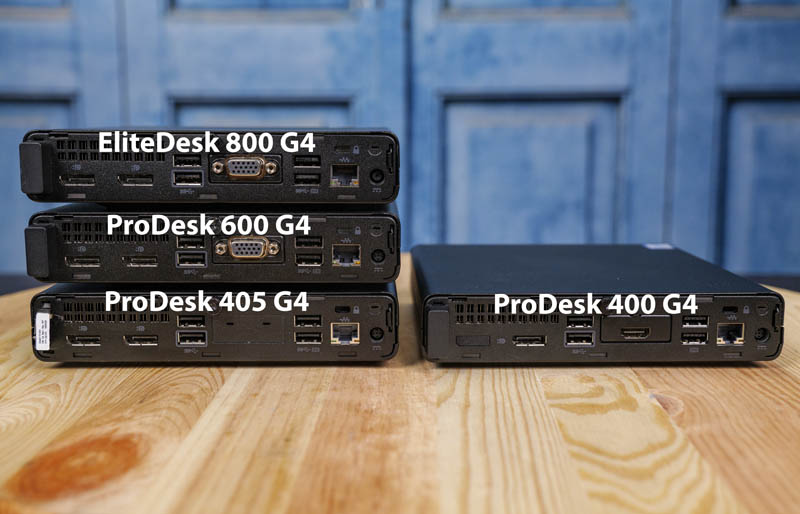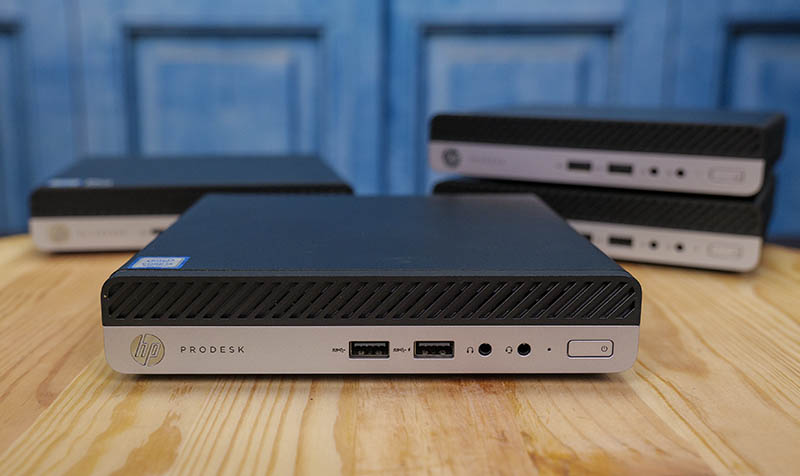Power Consumption
Idle power consumption on 120V power we saw 10-11W idle for the quad-core unit. We generally assume these nodes will use 9-12W idle so this is in that range. Again, these are used units so it may vary a bit.

The power supplies are 65W HP power adapters from the company’s notebook line. We hit 51W on our unit putting as much stress as we could on it. This is still a relatively low power consumption. Most nodes used for labs, or even as desktops, will sit idle most of the time.
At idle, the noise is not significant. Under CPU and/or GPU loads, the fan spins up and the system is audible. An advantage is that one can move this system to avoid direct noise by mounting it on the back of a TV or monitor, under a desk, or elsewhere. These are designed to be quiet so many of them can fill rooms of small cubicles or co-working desk space so these need to be designed to be relatively quiet.
Next, we are going to discuss key lessons learned before getting to our final thoughts.
Key Lesson Learned for TMM
In this series, we wanted to also focus on some key lessons learned. Since we have already tested well over a dozen different models, we are taking away key pieces of advice from each that we wanted to share.
Here, we found that the system itself is actually a nice unit, but we overpaid for it, even buying the lowest cost one we could find. When these units are new, they tend to sell for less than the HP EliteDesk line. On the secondary market, there is a smaller gap in price, which would have pushed us to the EliteDesk had we known.
HP EliteDesk v. ProDesk
We may end up doing a different article to reference on this, but here is the quick breakdown of the differences between the HP EliteDesk and the HP ProDesk lines:
The EliteDesk is the higher-end line while the ProDesk is the lower-end line in HP’s nomenclature. The EliteDesk gets longer product lifecycles, generally more testing, and features such as vPro that the ProDesk generally does not.

HP’s generation is denoted by a G# nomenclature in product names. This is an example of the ProDesk 400 G4 Mini, but we have looked at the HP EliteDesk 800 G2 Mini and the Project TinyMiniMicro HP EliteDesk 705 G3 Mini. We noted then that the 800 G2 Mini had features that seemed to be a generation ahead of the EliteDesk 705 G3 Mini. This is despite the higher numerical generation designation. This is the confusing part, but we validate this, the generations to not necessarily move together. Instead, they are generations of a line. This is very different from what HP and now HPE does on the data center side where we have generations of servers like HPE ProLiant MicroServer Gen10 Plus which gets a generation destination for cross-portfolio timing. On the desktop side, G# is on the particular model line, not for cross model comparison. That makes the generation very confusing.

The series number in this case the “400” is used to denote how high in the stack the unit is. For example, a ProDesk 600 we would expect to have better testing, security, and support features than the ProDesk 400. Also, HP usually gives more configuration options to the higher number models. There are also serviceability changes from the ProDesk 400 G4 Mini to the EliteDesk 800 G3/ G4 Mini. An example is that HP does more with tool-less service as one moves up the stack.
Although from the exterior the systems may look identical, and if you just look at high-level features such as the number of DIMMs and CPUs used, they may look similar, there are quite a few changes underneath.
Impact on Project TMM
With that primer out of the way, the impact was that we effectively paid EliteDesk 800 level pricing for a ProDesk 400 level feature set. Part of the reason for this is that we also have the ProDesk 405 G4 and we wanted to show the AMD version, which we will do in the future. That AMD version traded the 500GB HDD for a 256GB NVMe SSD, and added WiFi, while it cost $80 less. Likewise, we purchased an EliteDesk 800 G4 with WiFi and a Core i5-8500T for only $20 more which is completely worthwhile.
We are going to take a look at some of the ProDesk 400 G4 versus ProDesk 600 G4 differences in the future as once we learned how the naming works, just to see if we can spot the changes. Even that ProDesk 600 G4 had higher specs at a lower price.
The key takeaway is that one needs to look at more than just CPU, memory, and storage when purchasing these units. There are notable differences.
Again, the HP ProDesk 400 G4 Mini is not a bad system. We just overpaid for it because we had not yet mastered the HP product naming.
Final Words
The HP ProDesk 400 G4 Mini is a perfectly nice system. So long as one wants these features, then it makes a lot of sense. There are however trade-offs especially with features such as USB ports that we should have done a better job of. Also, the fact that the “Pro”Desk line does not support Intel v”Pro” may be confusing. Only the EliteDesk gets that, and only with compatible CPUs, and only in systems that are designed for it.

The Core i3-8100T is stuck somewhere in the middle of many other CPU options. It is not quite as fast as the Core i3-9100T so if pricing is equal, we would go with the newer CPU. Performance-wise, it is closer to the Intel Core i5-6500T, but the Core i5-6500T gets the higher-end feature set. We will note that TMM Plex users that want newer QuickSync will want the Core i3-8100T with the UHD 630 graphics instead of the older models with the 500 series iGPUs. Likewise, we would generally prefer the Intel i219LM 1GbE solution for something like a lab pfSense Firewall.
Perhaps the biggest takeaway here is just in terms of segmentation. While systems may make a lot of sense in terms of segmentation during the sales cycle, it becomes maddening looking at systems side-by-side. Adding a plastic tool-less 2.5″ drive tray and tool-less M.2 mounting does not logically seem like it should cost more than a solution that adds weight and service labor. Likewise, HP says it tests the EliteDesk to MIL-spec but not the ProDesk, but it is doing two suites of testing instead of one, adding cost. There are many areas where it seems like the segmentation costs HP more and feels like active devaluing of a product with the ProDesk 400 G4. Now that we are working on well over two dozen of the DDR4 generation systems from multiple vendors as part of Project TinyMiniMicro the segmentation trade-offs for the ProDesk 400 G4 feel less user-friendly. The system is still great, but it feels like an engineering team was actively tasked with making something that was artificially worse than the EliteDesk line. That is probably not a popular take, but over weeks of testing this unit, every time I picked it up something triggered that concept.
That feeling aside, the HP ProDesk 400 G4 Mini is a very nice unit. Working on the system one can immediately see that a lot of engineering time and creativity went into making the system. The ease of servicing even at the ProDesk 400 level is better than the Intel NUCs and similar systems we have tested. That is the refinement that has happened over many generations that one can see immediately in the unit.




@Patrick you bought an I3??? That is indeed way more than my EU 250,- HP Deskpro 400 G4 I5 8500T. Mine came withouth the Display port covers and no storage or wifi. And had useless VGA as option port. (Useless for me).
Could you try with 2x 32Gb ram. I know it is not supported by HP. Not asking for a friend but me myself and I.
I recently bought an i3 for online classes and it works fine.
I have an EliteDesk 800 G2 mini (Core i5 6500t) and a Prodesk 400 G4 mini (Core i5-8600T).
The Prodesk 400 G4 is supposed to be slightly faster and have faster graphics. In practice, is the G4 any better?
Unfortunately we have found the Prodesk 400 G4 to be significantly noisier than the EliteDesk 800 G2. Has anyone else found this? We are using the computers in a studio setting and need all equipment to be as quiet as possible.